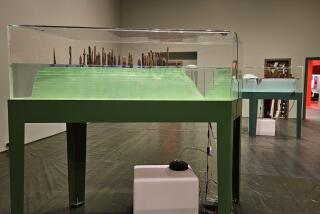ART REVIEW : KLINE AND ROTHKO: TWO VITAL REBELS
- Share via
SAN FRANCISCO — Back in the ‘50s, certain knowledgeable artniks were sure that the Abstract Expressionist fad would fade from memory as quickly as the name of last year’s Miss Rheingold. Surely, this art of splashes and smears was a hoax perpetuated by drunken beatniks who painted less well than chimpanzees and 5-year-olds. Even those willing to grudge a certain virtue to AE’s manic energy concluded that its expressive range was too narrow to be sustained.
A quarter-century later--with Decorative Abstraction forgotten and Op Art a dim memory--history is still sorting AE’s lions from AE’s goats. Clyfford Still has looked powerfully limited and Adolph Gottlieb too pretty, but nobody has denied them virtue or consigned the style as a whole to fame’s ash heap.
Now, two more of the rebel leaders are seen in depth at the San Francisco Museum of Modern Art. “The Vital Gesture” (to June 8) surveys Franz Kline’s painting in about 100 examples. Mark Rothko’s career is scanned in 60 works on paper (to June 29.)
Time has rendered the art less esoteric and more accessible. Kline’s sputtering skids of black and white once seemed purely abstract. Commentators compared the marks--rather desperately--to huge characters in Oriental calligraphy. (If they had to resort to such metaphors they’d have done better with Hebrew letters.) Now, like any art of substance, this imagery seems to derive from its environment. We Californians forget that a New Yorker like Kline spends a big chunk of his year looking at an essentially black-and-white world where dark silhouettes of girders and bare trees stand starkly against grimy snow or fade into a gray fog.
Kline, who died in 1962, was amiable and gregarious. Captain of his high school football team, he grew to good looks, an Errol Flynn mustache and an urge to entertain his friends. His pre-abstract work belies the Philistines notion that these guys couldn’t draw. Kline’s figurative work combined Ashcan School slanginess with a slightly lugubrious realist Expressionism found in artists like Max Weber. A bit of Pagliacci there. Among these works are a brooding portrait of the mad dancer Nijinsky, a synagogue interior and a jazz band that act neatly as metaphors of the virtually religious dedication to individuality and improvisation that Kline shared with his fellows.
Kline was once considered an artist of very narrow range. Just one black-and-white skid after the next. What does this guy do for an encore? Today, he looks remarkably varied, moving from pure bullheaded eccentricity to the Wagnerian sonority of “Siegfried” to “Leihei ‘V’ Span” where he paints like an ecstatic jazz drummer.
Kline was a dramatic painter but never merely theatrical. Even when he bordered on rhetorical melodrama, his compositions are saved by a lurking sense of tragedy that is now clearly a component of all the best Abstract Expressionist work.
Tragedy was certainly a hallmark of Mark Rothko’s art and later of his life. He died a suicide in 1970. Subsequently, his estate became the subject of a nasty and notorious lawsuit that made this most introverted and mystical art the subject of a mocking public spectacle exposing the venality of the art market. Art became life when existential tragedy and absurdity stood up and walked. The Rothko case is sometimes called Artgate. The sphere has never since quite recovered a reputation for integrity that it had before the case.
Rothko does not fare his best in works on paper. The large scale he established for his painting became a kind of absolute so that smaller works look miniaturized. There are some tender early figurative watercolors and some late, somber works that--surprisingly--anticipate the mood of Anselm Kieffer.
What finally keeps Abstract Expressionism alive for us is a present sense of classicism that derives from its integrity. These guys really were out on an existential limb with no idea if they would ultimately win. It was as if they all asked Jackson Pollock’s famous question: “Is this painting?”
In an institutionalized art world grown mired in careerism and hype, one is happy to reply that, yes, it is painting and its spirit is a little candle in the night.
More to Read
The biggest entertainment stories
Get our big stories about Hollywood, film, television, music, arts, culture and more right in your inbox as soon as they publish.
You may occasionally receive promotional content from the Los Angeles Times.










